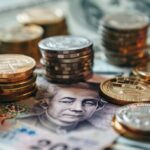- The Pound Sterling drops below 1.2500 as the US Dollar strengthens ahead of the announcement of the latest Fed policy decision.
- In a light economic calendar week in the UK, speculation for BoE rate cuts is expected to drive the Pound Sterling.
- Investors expect that the Fed will emphasize the need to maintain the current interest rate framework for longer.
The Pound Sterling (GBP) extends its downside below the psychological support of 1.2500 against the US Dollar (USD) during Wednesday’s London session. Due to the light economic calendar in the United Kingdom, the volatility in the GBP/USD pair all comes from the side of the US Dollar as the United States faces a data-packed week, starting with the Federal Reserve decision (Fed) later on Wednesday.
The Pound Sterling’s valuation will solely be impacted by expectations for interest-rate cuts by the Bank of England (BoE). Financial markets speculate that the BoE could opt to cut borrowing costs in the June or August meetings. Traders have priced in rate cuts soon as BoE Governor Andrew Bailey said he is confident that headline inflation will come down to 2% in April. In March, UK inflation stood at 3.2%.
The recent steep correction in the GBP/USD pair reflects uncertainty among investors ahead of the Fed interest rate decision, which will be announced at 18:00 GMT. The Fed is expected to maintain interest rates steady and to give hawkish rhetoric, as recent inflation data suggests persisting price pressures, making it difficult for policymakers to gain confidence that price growth will sustainably return to the 2% target. This scenario of higher interest rates in the US improves the appeal of the US Dollar and weighs on other currencies whose central banks are seen cutting rates earlier than the Fed.
The US Dollar Index (DXY), which tracks the Greenback’s value against six major currencies, advances to a two-week high of around 106.50.
Daily digest market movers: Pound Sterling drops as Fed looks set to maintain hawkish rhetoric
- The Pound Sterling corrects sharply to 1.2480 against the US Dollar as investors brace for the Federal Reserve’s monetary policy decision. The CME FedWatch tool shows that traders see interest rates remaining unchanged in the range of 5.25%-5.50% for the sixth time in a row. Though no action is expected on borrowing rates, investors will keenly watch for the interest rate outlook by looking at the Fed’s statement and Chairman Jerome Powell’s press conference.
- The Fed is expected to support the “higher for longer interest rates” argument as a recent batch of inflation indicators has suggested that progress in inflation declining to the 2% target has stalled.
- After higher-than-expected Consumer Price Index (CPI) and core Personal Consumption Expenditure Price Index (PCE) for March, Q1 Employment Cost Index also beat estimates by a strong margin. The index rose by 1.2%, higher than the consensus of 1.0% and the prior reading of 0.9%. Higher Employment Cost is generally driven by strong wage growth, which leads to an increase in consumer spending and fuels inflationary pressures.
- Before the Fed’s policy meeting, investors will keenly focus on the ADP Employment Change and the ISM Manufacturing PMI data for April, which will be released in the early New York session. The consensus shows that private employers recruited 175K jobs, slightly lower from 184K in March. The Manufacturing PMI is forecasted to drop to the borderline of 50.0 in April from 50.3 in March. The 50.0 figure is the threshold that separates expansion from contraction. A weaker-than-expected Manufacturing PMI will indicate that US factory activity contracted in April.
Technical Analysis: Pound Sterling trades below 1.2500
The Pound Sterling falls sharply against the US Dollar after failing to extend its upside above the crucial resistance of 1.2570. The GBP/USD pair also fails to sustain above the 20-day Exponential Moving Average (EMA) around 1.2510, indicating that the near-term outlook is still uncertain.
The neckline of the Head and Shoulders (H&S) pattern has acted as a strong barrier for the Pound Sterling bulls. On April 12, the Cable experienced an intense sell-off after breaking below the neckline of the H&S pattern plotted from December 8 low around 1.2500.
The 14-period Relative Strength Index (RSI) oscillates in the 40.00-60.00 range, suggesting indecisiveness among market participants.
Risk sentiment FAQS
In the world of financial jargon the two widely used terms “risk-on” and “risk off” refer to the level of risk that investors are willing to stomach during the period referenced. In a “risk-on” market, investors are optimistic about the future and more willing to buy risky assets. In a “risk-off” market investors start to ‘play it safe’ because they are worried about the future, and therefore buy less risky assets that are more certain of bringing a return, even if it is relatively modest.
Typically, during periods of “risk-on”, stock markets will rise, most commodities – except Gold – will also gain in value, since they benefit from a positive growth outlook. The currencies of nations that are heavy commodity exporters strengthen because of increased demand, and Cryptocurrencies rise. In a “risk-off” market, Bonds go up – especially major government Bonds – Gold shines, and safe-haven currencies such as the Japanese Yen, Swiss Franc and US Dollar all benefit.
The Australian Dollar (AUD), the Canadian Dollar (CAD), the New Zealand Dollar (NZD) and minor FX like the Ruble (RUB) and the South African Rand (ZAR), all tend to rise in markets that are “risk-on”. This is because the economies of these currencies are heavily reliant on commodity exports for growth, and commodities tend to rise in price during risk-on periods. This is because investors foresee greater demand for raw materials in the future due to heightened economic activity.
The major currencies that tend to rise during periods of “risk-off” are the US Dollar (USD), the Japanese Yen (JPY) and the Swiss Franc (CHF). The US Dollar, because it is the world’s reserve currency, and because in times of crisis investors buy US government debt, which is seen as safe because the largest economy in the world is unlikely to default. The Yen, from increased demand for Japanese government bonds, because a high proportion are held by domestic investors who are unlikely to dump them – even in a crisis. The Swiss Franc, because strict Swiss banking laws offer investors enhanced capital protection.
Read the full article here









